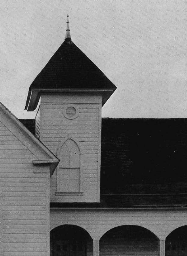Articles/Essays – Volume 01, No. 3
Early Mormon Churches in Utah: A Photographic Essay
The following photographs are geographically and, I believe, architecturally representative of early Mormon churches in Utah. I have concerned myself only with existing churches that were built between 1861 and 1905. A truly representative selection obviously would include a thorough search of the archives for pictures of buildings that have been razed.
However, I have not been primarily interested in making a photographic record of early churches, although this ought to be done in the near future. If these photographs someday prove valuable to a historian, I’ll be pleased; but the pleasure I take will be from a value that is secondary and derivative. Admittedly I was first motivated to take these photographs because of a growing apprehension that many of the old churches would be replaced before they were recorded on film. But later my personal response to them became immensely more important.
I began to suspect that a methodical, scholarly examination of churches would ultimately falsify my vision. There is a great difference between an architectural blueprint and a “diagram of prayer.” Seeing the church as a center of spiritual fulfillment, consecration, and purification is much more important than recording exposed beams or lintel ornamentation. The steeple is less important as an architectural achievement than as the embodiment of religious aspiration. To photograph a church without the spiritually creative power that went into it is the kind of falsification I have tried to avoid. Unfortunately, guarding against the trite, the superficial, and the picturesque often required more study than I had time for; consequently, I left many churches feeling that I had betrayed their significance.
In addition, a wholly unexpected problem arose when the photographs were assembled. As I traveled about the state taking pictures I saw the churches less as individual expressions of faith than as a living web of belief. I no longer saw the churches singly but in relationship to each other — a relationship that was dramatized by the distances I traveled and the diversity of locale. Brought together as photographs, shrinking space and time, the churches became vulnerable as a collection of historical curiosities or architectural eccentricities — dignified in some cases; in others, pathetic in their abondonment. I can only hope that these will be occasional rather than inevitable conclusions. I cannot supply in these photographs the sudden delight at finding a sturdy rock church set in well-watered fields or shaded by protective cottonwoods. The Pine Valley meeting house was built by a faith that brought Mormon pioneers thousands of miles and through countless hardships. Yet the church, with its minimum of ornamentation and so-called papal artistry, is simple and serene, reflecting the strength of purpose and the devotion of the people who built it.
The distances separating these churches is still great; in 1870 they were overwhelming. The environments were frequently inhospitable. The ease with which these churches in photographs can be examined seems to be in inverse ratio to the difficulties encountered when they were built.
[Editor’s Note: For photographs, see PDF below.]


 Back to full Issue
Back to full Issue

